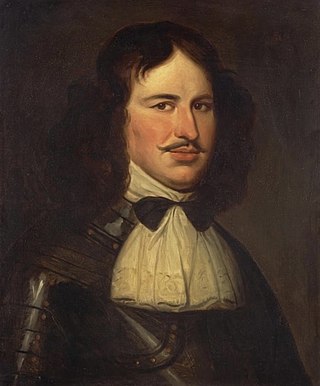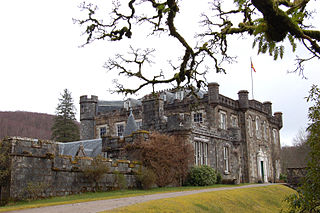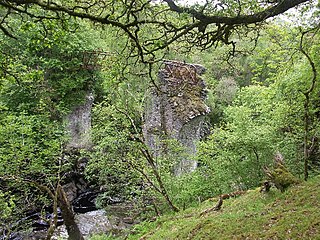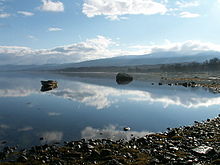
Fort William is a town in Lochaber in the Scottish Highlands, located on the eastern shore of Loch Linnhe. At the 2011 census, Fort William had a population of 10,459, making it the second largest settlement in both the Highland council area, and the whole of the Scottish Highlands; only the city of Inverness has a larger population.

Glenfinnan is a hamlet in Lochaber area of the Highlands of Scotland. In 1745 the Jacobite rising began here when Prince Charles Edward Stuart raised his standard on the shores of Loch Shiel. Seventy years later, the 18 m (60 ft) Glenfinnan Monument, at the head of the loch, was erected to commemorate the historic event.

Sir Ewen Cameron of Lochiel was a Scottish soldier, Jacobite and the 17th Chief of Clan Cameron. He fought as a Cavalier during the Civil War and was one of the main leaders during the Jacobite rising of 1689. He is regarded as one of the most formidable Highland chiefs of all time, with Lord Macaulay describing him as the "Ulysses of the Highlands." An incident demonstrating his strength and ferocity in single combat, when he bit out the throat of an enemy, is used by Sir Walter Scott in Lady of the Lake.

Clan Mackintosh is a Scottish clan from Inverness in the Scottish Highlands. The chiefs of the clan are the Mackintoshes of Mackintosh. Another branch of the clan, the Mackintoshes of Torcastle, are the chiefs of Clan Chattan, a historic confederation of clans.

Ardgour is an area of the Scottish Highlands on the western shore of Loch Linnhe. It lies north of the district of Morvern and east of the district of Sunart. Administratively it is now part of the ward management area of Lochaber, in Highland council area. It forms part of the traditional shire and current registration county of Argyll.

Achnacarry is a hamlet, private estate, and a castle in the Lochaber region of the Highlands, Scotland. It occupies a strategic position on an isthmus between Loch Lochy to the east, and Loch Arkaig to the west.

Clan Cameron is a West Highland Scottish clan, with one main branch Lochiel, and numerous cadet branches. The Clan Cameron lands are in Lochaber and within their lands lies Ben Nevis which is the highest mountain in the British Isles. The Chief of the clan is customarily referred to as simply "Lochiel".

Clan MacDonald of Keppoch, also known as Clan MacDonellof Keppoch or Clan Ranald of Lochaber, is a Highland Scottish clan and a branch of Clan Donald. The progenitor of the clan is Alistair Carrach MacDonald, 4th great-grandson of the warrior Somerled. The clan chief is traditionally designated as the "Son of Ranald's son".

Clan MacMillan is a Highland Scottish clan. The Clan was originally located in the Lochaber area of the Scottish Highlands during the 12th century. The clan supported Robert the Bruce during the Wars of Scottish Independence, but later supported the Lord of the Isles in opposition to the Scottish Crown. During the Jacobite rising of 1745 the clan was divided with some supporting the Jacobites and others not taking part in the rebellion.

The Highbridge Skirmish was the first engagement of the Jacobite Rising of 1745 between government troops and Jacobites loyal to Prince Charles Edward Stuart. It took place at Highbridge, Lochaber, on the River Spean on 16 August 1745, and marked the commencement of hostilities between the two sides.

Archibald Cameron of Lochiel was a Scottish physician and prominent leader in the Jacobite rising of 1745. He was the personal physician of Charles Edward Stuart, and younger brother of Donald Cameron of Lochiel, otherwise known as the Gentle Lochiel, who led Clan Cameron during the rising. In 1753 at Tyburn, he was executed for high treason, being the last Jacobite to be executed. In popular memory, he is sometimes referred to as Doctor Archie.

Donald Cameron of Lochiel, popularly known as the Gentle Lochiel, was a Scottish Jacobite, soldier and hereditary chief of Clan Cameron, traditionally loyal to the exiled House of Stuart. His support for Prince Charles Edward Stuart proved pivotal in the early stages of the 1745 Jacobite Rising. Lochiel was among the Highlanders defeated at the Battle of Culloden, and thereafter fled to France.

Lochiel is a small town in the Mid North of South Australia 125 km (78 mi) north of Adelaide. The town lies beside on the western edge of Lake Bumbunga and at the eastern foot of the Hummocks Range. The Augusta Highway, a section of Highway 1, runs on a strip between the township and the lake, which dwarfs the former.

The Battle of Achnashellach was a Scottish clan battle said to have taken place in the year 1505, in the Scottish Highlands at Achnashellach. It was fought by the Clan Cameron against the Clan Mackay and the Clan Munro.

The A861 road is a circuitous, primarily coastal, road in Lochaber, within the Highland council area of Scotland.

The Battle of Bun Garbhain was a Scottish clan battle fought in 1570, in the Scottish Highlands, between the Clan Cameron and the Clan Mackintosh.

The Prince's Cairn marks the traditional spot from where Prince Charles Edward Stuart embarked for France from Scotland on 20 September 1746 following the failure of the Jacobite rising of 1745. The cairn is located on the shores of Loch nan Uamh in Lochaber. It was erected in 1956 by the 1745 Association, a historical society dedicated to the study, recording and preservation of memories from the Jacobite period.
Fassfern is a hamlet on the north shore of Loch Eil in the Scottish Highlands, at the bottom of Glen Suileag and almost opposite Duisky. Historically it was spelled Fassiefern.
The Camerons of Erracht were a minor noble Scottish family and a branch of the Clan Cameron, a Highland Scottish clan. In Scottish Gaelic they are known as the Sliochd Eòghain mhic Eòghain.

Clan MacPhail or the Sons of Paul is a Scottish clan of the Scottish Highlands. Known in Scottish Gaelic as Conchie Dhu or Condochy Doye, the clan is mainly associated with the confederation of Clan Chattan.





















